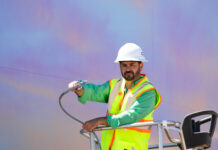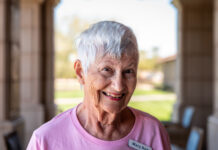Here’s a statistic that’s sure to spook adults. According to the Centers for Disease Control and Prevention, children are four times more likely to be hit by a vehicle on Halloween than on any other day of the year.
That’s because most trick-or-treating happens at night, with excited witches, goblins and superheroes scurrying through neighborhoods in search of delectable treats. Hundreds of children will be out trick-or-treating after dark on Halloween–so be extra careful and have fun!

The American Red Cross offers these safety tips for children, parents and drivers:
Tips for Children:
Plan your route and, if possible, have an adult go with you.
Walk, slither, and sneak on sidewalks, not in the street. If there are no sidewalks, walk on the left side of the road, facing traffic.
Look both ways before crossing the street to check for cars, trucks and low-flying brooms.
Cross the street only at corners, not in the middle of the block and stay together in a group before crossing.
Never hide or cross the street between parked cars.
Wear light-colored or reflective clothing so you are more visible. (And remember to put reflective tape on bikes, skateboards and brooms, too!)
Use face paint rather than masks or big floppy hats that will cover your eyes.
Don’t wear long, baggy, or loose costumes or extra-large shoes–you could trip and fall!
Carry a flashlight to light your way.
Keep away from open fires and candles. (Costumes can be extremely flammable.) If a costume catches fire, STOP, DROP and ROLL.
Only visit well-lit homes that have a porch light on.
Accept treats at the door; never go into a stranger’s house or apartment.
Be cautious of animals and strangers.
Have a grown-up inspect your treats before eating them.
Don’t eat candy if the package has already been opened.

Tips for Parents:
Establish a route in a well-known neighborhood and discuss it with your kids.
Review Halloween safety precautions with children, including pedestrian and traffic safety rules.
Accompany children under age 12–either you, another responsible adult or an older youth.
Remember that masks that can restrict peripheral vision and hearing and oversized or loose costumes and shoes can cause children to trip and fall.
Choose a firm return time.
Make sure children know their phone number and carry a cell phone.
Purchase fire retardant/fireproof costumes. Check the tag/label on the costume to make sure it’s flame-resistant.
Make sure your older children are carrying ID.
Have children use flexible costume knives and swords, not ones that are rigid or sharp.
Ask children to bring treats home before eating them so you can inspect them. Remember: small, hard pieces of candy are a choking hazard for young children.
Call your local poison control center if you believe your child has eaten something tainted.
Flush eyes with cool water should face paint, glitter or shaving cream get into eyes.
Prepare for trick-or-treaters by clearing porches, lawns and sidewalks and placing jack-o-lanterns away from doorways or landings.

Tips for Drivers:
Slow down in residential neighborhoods (drive at least five miles under the speed limit) to give yourself time to react to excited trick-or-treaters who might dart into the street, especially mid-block or from between parked cars.
Broaden your visual scanning–look to your right and left, into front yards and onto porches.
Watch carefully for small superheroes, vampires and goblins in dark costumes walking on the road, medians and curbs; they can be hard to see after dark.
Use caution when exiting driveways and alleyways.
Turn on your vehicle’s headlights, even during the day.
They make you more visible.
Here’s to a safe but Happy Halloween!

![Locals find zen with Earth Day drum circle Lizz Fiedorczyk instructs a drum circle at Maricopa Community Center April 22, 2024. [Brian Petersheim Jr.]](https://www.inmaricopa.com/wp-content/uploads/2024/04/PJ_3922-Enhanced-NR-218x150.jpg)


![Shred-A-Thon to take place tomorrow An image of shredded paper. [Pixabay]](https://www.inmaricopa.com/wp-content/uploads/2024/03/shredded-paper-168650_1280-218x150.jpg)











![Alleged car thief released without charges Phoenix police stop a stolen vehicle on April 20, 2024. [Facebook]](https://www.inmaricopa.com/wp-content/uploads/2024/04/IMG_5040-100x70.jpg)
![Locals find zen with Earth Day drum circle Lizz Fiedorczyk instructs a drum circle at Maricopa Community Center April 22, 2024. [Brian Petersheim Jr.]](https://www.inmaricopa.com/wp-content/uploads/2024/04/PJ_3922-Enhanced-NR-100x70.jpg)